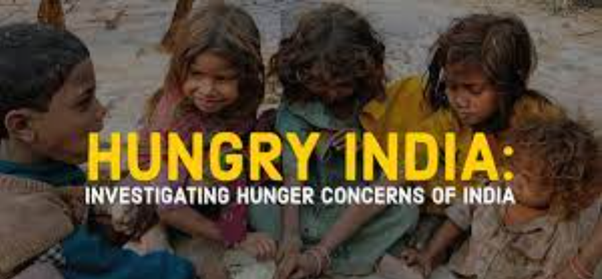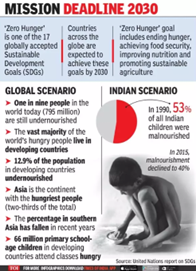The Hunger Challenge.
Relevance
- GS Paper 2 Issues Relating to Poverty and Hunger.
- Tags: #hunger #zerohunger #theindianexpress #upsc
Why in the News?
- Prime Minister Narendra Modi’s proclamation of uplifting 135 million people out of poverty over the five-year span from 2015-16 to 2019-21.
- This achievement was measured by the Multi-dimensional Poverty Index (MDPI) formulated by NITI Aayog, although the UNDP previously estimated the removal of 415 million people from poverty between 2005-06 and 2019-21.
- This marked a significant stride towards addressing the post-independence goal of eradicating poverty, hunger, and malnutrition.
What is hunger?
Hunger, as outlined by the Food and Agriculture Organization (FAO), refers to the persistent (or chronic) intake of insufficient calories to meet an individual’s fundamental dietary energy needs for a vibrant and productive life. It entails an uncomfortable or distressing bodily sensation arising from inadequate consumption of dietary energy and is a prominent indicator of poverty.
Types of hunger
- Acute Hunger
Acute hunger refers to insufficient nourishment occurring within a specific timeframe. The most severe manifestation of acute hunger emerges during crises like El Niño-induced droughts, conflicts, and similar situations.
- Chronic Hunger
Chronic hunger signifies a prolonged state of inadequate nourishment. The body absorbs fewer nutrients than required, often stemming from conditions of poverty
- Hidden Hunger
Hidden hunger represents a variant of chronic hunger. It results from an imbalanced diet, leading to a deficiency in essential nutrients like iron, iodine, zinc, and vitamin A.
Causes of Hunger
- Poverty: Limited food options due to poverty leads to hunger-related deaths, exacerbated by high food prices and regional disparities in development.
- Ineffective Policy Implementation: Poor execution of schemes like ICDS and NHM contributes to persistent hunger.
- Micronutrient Deficiency: India grapples with micronutrient deficiency, linked to insufficient diets, disease, and unmet needs during pregnancy and lactation.
- Gender Disparity: Girls suffer due to patriarchal norms, often receiving less food and missing mid-day meals due to limited school access, perpetuating inequality.
- Hidden Hunger: Inaccurate poverty line categorization, coupled with low-quality grains, diminishes food consumption.
- Knowledge Gap: Limited understanding of nutrition, breastfeeding, and parenting among mothers hinders effective child care.
- Resource Depletion and Climate Impact: Resource misuse hits the marginalized, struggling to adapt. Climate change-driven desertification, soil erosion, and extreme weather disproportionately affect the poor, intensifying hunger.
- Natural Calamities: Weather extremes, like droughts and floods, devastate harvests, leaving vulnerable populations in dire hunger crises.
- Associated Factors: Hunger results from water scarcity, poor sanitation, and inadequate access to food. Demographics like gender and age also affect nutritional well-being.
Government Initiatives
- Eat Right India Movement: Conducted by FSSAI, it encourages citizens to adopt healthier eating habits.
- POSHAN Abhiyan: Ministry of Women and Child Development’s initiative since 2018, addressing stunting, undernutrition, and aneamia among young children, women, and girls.
- Mid-day Meal (MDM) Scheme: Enhances school children’s nutrition, positively impacting enrolment and attendance.
- Pradhan Mantri Matru Vandana Yojana: Managed by Ministry of Women and Child Development, offering maternity benefits across all districts since January 2017.
- Food Fortification: Enriches staple foods like rice, milk, and salt with essential nutrients, improving their nutritional value.
- National Food Security Act, 2013: Legally entitles 75% of rural and 50% of urban populations to subsidized food grains through Targeted Public Distribution System.
- Mission Indradhanush: Targets immunization of children under 2 years and pregnant women against 12 Vaccine-Preventable Diseases.
- Integrated Child Development Services (ICDS) Scheme: Initiated in 1975, offers services to children aged 0-6 years, pregnant women, and lactating mothers.
Achievements in Poverty Reduction
- Post-independence, India faced immense challenges with over 80 percent of its population steeped in extreme poverty. Remarkably, this figure has now dwindled to approximately 15 percent according to the MDPI, and around 11 percent based on an income criterion of $2.15 PPP.
- This impressive decline in poverty rates is attributed to successive governments’ varied contributions and, significantly, the policy shifts towards a market-oriented economy starting from 1991. India’s economic transformation is reflected in its foreign exchange reserves, which have surged to around $600 billion, boosting economic resilience.
- Uplifted 135 million people out of poverty over the five-year span from 2015-16 to 2019-21.
Current Status of hunger and malnutrition in India
- The National Family Health Survey (NFHS-5, 2019-21) reveals disturbing statistics, with 32 percent of children underweight, 35 percent stunted, and 19 percent wasted.
- Despite significant improvements in infant mortality rates from 57 percent in 2005-06 to 35 percent in 2019-21, progress in tackling malnutrition remains inadequate, demanding urgent attention from the government.
- According to the World Health Organization, at six months of age, 33 per cent of the daily calorie intake is expected to come from food.
- This proportion increases to 61 per cent at 12 months of age. The recommended calorie percentages mentioned here are the minimum amount that should come from food. For instance, India ranked 107 out of 121 countries in Global hunger index.
- Close to 40% did not eat any grains (roti, rice, etc) for an entire day, and six out of 10 children do not consume milk (“zero-milk”).
- According to the WHO, a minimum of 33% of the daily calorie intake is expected to come from food (at six months of age)
Role of Gender-Sensitive Growth and Agriculture
- Empowering Women Farmers: Enabling women’s access to resources, training, and credit can enhance agricultural productivity. Currently, women constitute 43% of the agricultural labor force, contributing significantly to food production. (Source: World Bank).
- Agricultural revolutions: Green revolution for food grains, milk revolution for increasing milk production, pink revolution, gene revolution for cotton cultivation has created multiple revenues for
- Diverse Agricultural Practices: Integrating women’s indigenous knowledge and practices into agriculture promotes crop diversity and resilience. In India, women manage around 15% of agricultural land, playing a crucial role in maintaining agro-biodiversity. (Source: FAO)
- Nutrition-Sensitive Agriculture: Gender-sensitive agricultural practices can boost the production of nutrient-rich crops, combating malnutrition. For instance, promoting cultivation of iron and vitamin A-rich foods benefits women and children’s health. (Source: UN Women)
- Access to Markets: Gender-inclusive growth enhances women farmers’ market access, improving income and food security. Increased participation in markets can raise rural women’s income by up to 79%. (Source: IFAD)
- Rural Employment Opportunities: Gender-sensitive rural employment schemes, like MGNREGA, provide income to women, contributing to family food security. Women’s participation in MGNREGA increased from 48% in 2008-09 to 56% in 2018-19. (Source: Ministry of Rural Development, GoI)
- Impact on Children: Women’s improved income and nutritional awareness positively influence children’s health. Maternal income growth has a significant association with reductions in child undernutrition. (Source: The Lancet)
- Policy Reforms: Gender-sensitive policies in agriculture, such as land rights for women and targeted extension services, can lead to better yields and food availability. Women with land ownership are more likely to invest in sustainable farming practices. (Source: NITI Aayog)
Gender-sensitive growth and agriculture play pivotal roles in achieving India’s goal of zero hunger. By acknowledging and addressing the gender disparities within the agricultural sector, India can make substantial progress towards eliminating hunger and malnutrition.
Steps to Eradicate Hunger in India
Resolving India’s hunger challenge demands a multifaceted approach tackling root causes. Key strategies include
- Poverty Alleviation: Elevating economic status via job creation and improved education access to combat hunger and malnutrition.
- Enhanced Distribution Systems: Bolstering public distribution systems for equitable and efficient food allocation.
- Agricultural Productivity Boost: Elevating agricultural output through advanced irrigation, superior seeds, and technology adoption for increased food availability.
- Promoting Nutritional Diversity: Advocating varied diets with focus on fruits, vegetables, and protein-rich sources to enhance nutritional intake.
- Maternal and Child Health Focus: Empowering maternal and child health via breastfeeding promotion, adequate nutrition, and immunization.
- Gender Equity: Curtailing gender disparities and promoting girls’ education to enhance nutritional intake and reduce malnutrition.
- Robust Monitoring: Establishing rigorous monitoring and evaluation systems to ensure efficacy and efficient implementation of nutritional programs.
While India has made commendable strides in poverty reduction, the fight against malnutrition remains an ongoing battle. A comprehensive approach combining gender-sensitive growth, improved education for women, enhanced agriculture productivity, and climate-resilient food systems is vital to address these challenges. Through well-planned policies and inclusive economic growth, India can make significant headway towards a future free from hunger and malnutrition.
| Global Hunger Index (GHI)
Established in 2006, the GHI was initially co-published by the International Food Policy Research Institute (IFPRI) and Welthungerhilfe based in the US and Germany respectively. In 2007, Concern Worldwide, an Irish NGO, also joined as a co-publisher. Subsequently, IFPRI withdrew its involvement in 2018, and the GHI became a joint effort of Welthungerhilfe and Concern Worldwide. The GHI serves as a comprehensive tool to assess and monitor hunger across global, regional, and national levels. Components and Scoring GHI scores are derived from four key indicators:
Scoring Scale The GHI rates hunger on a 100-point scale, with 0 denoting the best score (no hunger) and 100 being the worst. Nations’ GHI scores are categorized by severity, ranging from low to extremely alarming. Global Hunger Index 2022 Insights Regional Rankings India ranks 107 out of 121 countries, performing better than only war-affected Afghanistan among South Asian nations. Child Wasting Rate India’s child wasting rate, at 19.3%, surpasses the levels of 2014 (15.1%) and 2000 (17.15%). This alarming rate is the world’s highest and contributes significantly to the region’s average due to India’s large population. Undernourishment Prevalence India’s undernourishment prevalence increased from 14.6% (2018-2020) to 16.3% (2019-2021). This translates to 224.3 million undernourished individuals in India out of the global total of 828 million. Child Stunting and Mortality Improvements India has witnessed progress in these indicators. Child stunting declined from 38.7% (2014) to 35.5% (2022), and child mortality decreased from 4.6% (2014) to 3.3% (2022). The GHI underscores the critical need to address hunger, especially acute issues such as child wasting and rising undernourishment, while celebrating the improvements made in child stunting and mortality. |
Sources: Indian Express
Mains Question
Discuss India’s malnutrition scenario, propose gender-sensitive growth strategies, and elucidate agriculture’s role in combating malnutrition. 250 words.





